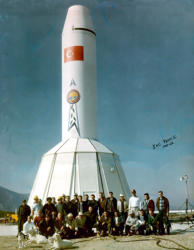
Jupiter SM-78 Weapon System
I&C Team 2, Çigli AB, Turkey 1961-1962 Chrysler Corporation Missile DivisionHISTORY - Page 23
begin with the firing of a REDSTONE in April 1956, and after that 35 more of these missiles would be used in
support of JUPITER development. According to ABMA. plans, major assemblies and components or sub-
components would be procured from prime contractor production, and would be modified at the arsenal
to suit a special mission. As the JUPITER prototype version was approached, the first 10 such missiles would
be assembled at Redstone, too. Afterwards, through prototype number 18, the contractor would assemble
the odd-numbered vehicles and Redstone the even-numbered, and this would continue at the rate of two
per month to the end of a 50-missile program. Contractor-produced missiles would be subjected to final
modifications and testing (static and otherwise), and instrumented according to the R&D needs at the
Arsenal.
ABMA envisioned that the first production missiles would be ready for field troops by June 1960 or earlier.
Funding estimates were $43.14 million for FY 1956 and $96.52 million for FY 1957, with a total program cost
estimated at $452.21 million.
The accomplishment of the development goal, according to ABMA's belief, would depend on the resolution
of two major problem areas. These were engines and range facilities. Four ballistic missile programs were
largely dependent on NAA's 150,000-pound-thrust engine production, and Army negotiators were
experiencing difficulty obtaining Western Development Division* approval on delivery dates to meet the
Army-Navy IRBM development schedule. The second problem related to range facilities at Patrick Air Force
______________________________
* Later renamed Air Force Ballistic Missile Division (AFBMD) and divided in 1961 into Space Systems Division (SSD) and Ballistic Systems Division (BSD).









HISTORY - Page 23
begin with the firing of a REDSTONE in April 1956, and
after that 35 more of these missiles would be used in
support of JUPITER development. According to ABMA.
plans, major assemblies and components or
subcomponents would be procured from prime
contractor production, and would be modified at the
arsenal to suit a special mission. As the JUPITER
prototype version was approached, the first 10 such
missiles would be assembled at Redstone, too.
Afterwards, through prototype number 18, the
contractor would assemble the odd-numbered
vehicles and Redstone the even-numbered, and this
would continue at the rate of two per month to the
end of a 50-missile program. Contractor-produced
missiles would be subjected to final modifications
and testing (static and otherwise), and instrumented
according to the R&D needs at the Arsenal.
ABMA envisioned that the first production missiles
would be ready for field troops by June 1960 or
earlier. Funding estimates were $43.14 million for FY
1956 and $96.52 million for FY 1957, with a total
program cost estimated at $452.21 million.
The accomplishment of the development goal,
according to ABMA's belief, would depend on the
resolution of two major problem areas. These were
engines and range facilities. Four ballistic missile
programs were largely dependent on NAA's 150,000-
pound-thrust engine production, and Army
negotiators were experiencing difficulty obtaining
Western Development Division* approval on delivery
dates to meet the Army-Navy IRBM development
schedule. The second problem related to range
facilities at Patrick Air Force
______________________________
* Later renamed Air Force Ballistic Missile Division (AFBMD) and divided in 1961 into Space Systems Division (SSD)
and Ballistic Systems Division (BSD).





















